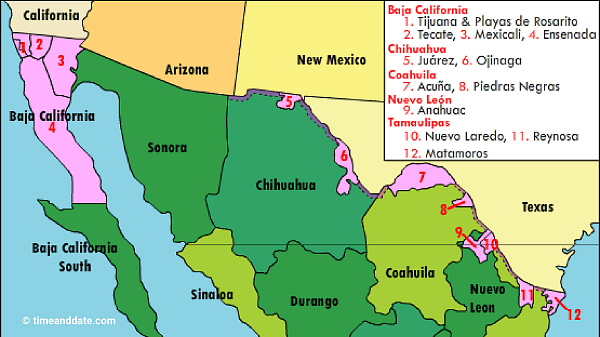Northern Mexican Border's New Daylight Saving Plan
Northern Mexico’s border cities will share the same daylight saving schedule as the United States from 2010 onwards.

Map of DST schedule in USA 2010
Northern Mexico’s border cities will soon share the same daylight saving schedule as the United States. The new DST schedule will see these border cities extending their daylight saving time (DST) to last from the second Sunday of March to the first Sunday of November, which is in line with the United States’ DST schedule.
Mexico’s Chamber of Deputies, as well as the Senate, have both approved a proposal for northern Mexico’s border cities to share the same daylight saving schedule with the United States. The synchronized schedule for the border cities will begin on Sunday, March 14, 2010.
New DST Schedule for Northern Mexico
Mexico’s Congress passed a law in December 2009, bringing the DST schedule observed by northern Mexico’s border cities to be in line with the United States' DST schedule. The daylight saving arrangement will affect the following areas:
- Tijuana & Playas de Rosarito.
- Ensenada.
- Mexicali.
- Tecate.
- Ciudad Juarez.
- Ojinaga.
- Ciudad Acuña.
- Piedras Negras.
- Anahuac.
- Nuevo Laredo.
- Reynosa.
- Matamoros.
The synchronized daylight saving schedule also applies to towns on the Mexico’s’ northern border between “the international line and the pipeline located at a distance of 20 kilometers (about 12 miles)". The revised DST arrangement also affects to the municipality of Ensenada in Baja California.
The new DST schedule will see these areas move the clocks forward from 2am (02:00) to 3am (03:00) local time on the second Sunday of March, and then back from 2am (02:00) to 1am (01:00) local time on the first Sunday of November. This schedule is synchronized with DST schedule set in the United States’ Energy Policy Act of 2005.

Mexico's northern border area, including Tijuana (pictured above) will have a daylight saving schedule that is in line with the USA's daylight saving schedule.
©iStockphoto.com/Christa Brunt
Border Areas’ Past Dilemma
The push for the amended DST schedule came in light of concern that, with the nation’s current DST schedule, business hours were not always synchronized between US/Mexico border cities and towns, which share strong socio-economic relations.
The United States’ daylight saving schedule annually starts on the second Sunday of March and ends on first Sunday of November. Northern Mexico’s border cities and towns used to follow national law that saw most of the country (except Sonora) following a DST schedule that begins on the first Sunday of April and ends on the last Sunday of October.
Many people, including political leaders, living in northern Mexico’s border areas complained that the country’s DST schedule was nearly one month behind the US schedule when it started, and about one week behind the US schedule when it ended. People living and working around the border areas needed to remember the one-hour time difference during the period when DST was not synchronized between the borders.